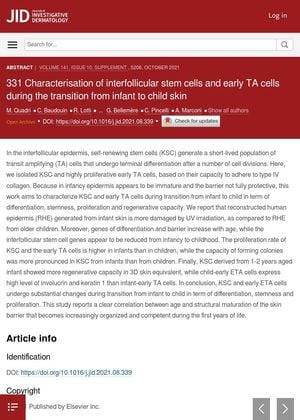Characterization of Interfollicular Stem Cells and Early TA Cells During the Transition From Infant to Child Skin
October 2021
in “
Journal of Investigative Dermatology
”
interfollicular stem cells early transit amplifying cells UV damage differentiation barrier protection proliferation rate regenerative capacity 3D skin equivalents stemness structural maturation skin barrier stem cells TA cells skin differentiation skin barrier protection cell proliferation 3D skin models skin maturation

TLDR The study concludes that as skin matures from infancy to childhood, there are major changes in cell differentiation, stemness, and growth, leading to a stronger skin barrier in older children.
The study "Characterisation of interfollicular stem cells and early TA cells during the transition from infant to child skin" aimed to understand the changes in stem cells and early transit amplifying (TA) cells as skin matures from infancy to childhood. The researchers found that the skin of infants is more susceptible to UV damage compared to older children. As children age, genes related to differentiation and barrier protection increase, while stem cell genes decrease. The proliferation rate of stem cells and early TA cells is higher in infants, and these cells from infants also have a greater capacity to form colonies. The regenerative capacity of stem cells derived from 1-2 year old infants was higher in 3D skin equivalents. The study concludes that there are significant changes in differentiation, stemness, and proliferation of these cells as skin matures from infancy to childhood, with a clear correlation between age and the structural maturation of the skin barrier.